
95% of researchers rate our articles as excellent or good
Learn more about the work of our research integrity team to safeguard the quality of each article we publish.
Find out more
ORIGINAL RESEARCH article
Front. Sustain. Food Syst. , 15 October 2020
Sec. Crop Biology and Sustainability
Volume 4 - 2020 | https://doi.org/10.3389/fsufs.2020.564586
This article is part of the Research Topic Intercropping Systems in Sustainable Agriculture View all 17 articles
Improvements in soybean (Glycine max [L.] Merrill) and wheat (Triticum aestivum L.) yields in cropping systems under no-till management (NTM) in the subtropics have been obtained through advances in phosphorus (P) utilization, cultivar selection, and planting and harvesting strategies. This fact, along with the P application in band application in consolidated planting, has resulted in adequate P utilization efficiency and small depleted soil P levels. The aim of this study was to evaluate the efficiency of P2O5 rates and application methods in soybean-wheat cropping under NTM during two growing seasons (2014–2016) in a Typical Eutrorthox. Four P2O5 rates (0, 30, 60, and 120 kg ha−1) of triple superphosphate (45% P2O5) were applied using two application methods (broadcast and band application at sowing) before the soybean and wheat crops were cultivated. Both P application methods resulted in a significant yield response to P2O5 rates for the soybean and wheat crops. Under NTM, broadcast P2O5 application was more effective than band application in soybean, and maximum grain yields were obtained with 129.3 and 88.1 kg P2O5 ha−1, respectively. Maximum wheat grain yields were obtained with 91.8 and 99.7 kg P2O5 ha−1 for broadcast and band application, respectively. Except for total P in leaves, nutrient uptake and yield components were not affected by the P application methods and rates. The results suggested that in soils with adequate available P levels of >15 mg kg−1 (Mehlich 1 extractant), the grain yield is equivalent or superior with broadcast P application as compared with band application for both soybean and wheat crops when cultivated in a Typical Eutrorthox under subtropical conditions. However, broadcast application is considered more effective for large areas of grain cultivation, where it is necessary to sow crops uniformly within the shortest possible time.
- Phosphorus (P) application increased soybean and wheat grain yield independently of application method.
- Broadcast P2O5 application in a consolidated no-till management was efficient in making P available to plants.
- The P2O5 application methods (broadcast and band application) did not influence the nutritional status of soybean and wheat plants.
- Our study provides a comprehensive survey of the response of application type (broadcast and band application) and P2O5 rates in soybean-wheat cropping system in no-till management and provides novel insights to improve the sustainability and quality of P (P2O5) fertilization under subtropical conditions.
Most soils in Brazil are deficient in phosphorus (P). Associated crop plant P deficiencies are more evident in grain crops, and result in reduced plant size, low pod insertion height, and small ears (Sfredo, 2008). In no-till management (NTM), crop rotation and/or cropping system in tropical and subtropical climates became viable only with the development of technologies to increase the use efficiency of fertilizers and correctives in different soil types in these regions. In these places, the use of large amounts of fertilizer, combined with the absence of abundant reserves of phosphate rocks of sedimentary origin and the need to maximize the time between one cultivation and the next, justifies studies to investigate optimization of phosphate fertilizer use efficiency in agriculture.
Crop rotation is feasible for several crops as it provides continuous soil protection, a good amount of soil organic matter (SOM), and nutrient accumulation which are of fundamental importance for maintaining high yields over the years. No-till management involves the implantation of crops in unturned soil and their protection by cover with straw residues. In NTM, the soil is not de-structured; however, this approach is restricted to band application (Fidelis et al., 2003).
The management of phosphate fertilizer influences the availability of nutrients in the soil and in the plants (Hansel, 2019). The application method can change the speed and capacity of the fertilizer to react in the soil, which in turn can change the solubilization and P availability for the plant, influencing the use efficiency (Lacerda et al., 2015). Fertilizer application must be planned from a long-term perspective, since the cost of fertilization and the responses in productivity are subject to many uncertainties and may vary from year to year (Fixen and Halvorson, 1991; Resende et al., 2006). Among the systems adopted, there are controversies about the ways of supplying the soil with adequate P levels since soluble phosphates, while promptly making P available, have shown good results in different application forms (Borges and Mallarino, 2003).
The use of soybean (Glycine max [L.] Merril) and wheat (Triticum aestivum L.) in a single cropping system is common in southern Brazil. Both crops benefit from this management system: the higher soil fertility requirement for wheat cultivation results in greater soil nutrient uptake in the straw, mainly P, and contributes to a reduction of fertilization needed for soybean crops, while wheat and other cereals benefit from the provision of significant amounts of N, P, and K left by soybean crop residues (Stainer et al., 2000; Rossi et al., 2013).
There are controversies about the efficiency of P2O5 application in relation to the method used (broadcast or band application) and the appropriate rate. Therefore, the objective of this study was to determine if the method and rate of P2O5 application has an influence on soil fertility, grain yield (GY), yield components, and nutritional status of soybean and wheat crops grown under subtropical conditions in a Kaolinitic Typical Eutrorthox.
The experiment was carried out in the field under rainfed conditions in an NTM (operational for 10 years). The study was conducted across two growing seasons (2014–2015 and 2015–2016) in the same field rotation located in Londrina, Paraná State, in southern Brazil (23° 23′ 30″ LS and 51° 11′ 05″ LW) (Figure 1). The soil, classified as a loamy (710 g kg−1 clay) Kaolinitic Typical Eutrorthox (USDA, soil taxonomy classification), had the following chemical properties (determined at a depth of 0–0.1 m) prior to soybean cultivation: pH (CaCl2) = 4.9, soil organic matter (SOM) = 31.3 g kg−1, P (Mehlich 1 extractant) = 3.7 mg kg−1, P (Resin extractant) = 9.1 mg kg−1, potassium (K+) (Mehlich 1) = 0.7 cmolc kg−1, calcium (Ca2+) (KCl, 1.0 mol L−1) = 5.1 cmolc kg−1, magnesium (Mg2+) (KCl, 1.0 mol L−1) = 1.9 cmolc kg−1, sulfur () = 79.1 mg kg−1, aluminum (Al3+) = 0.1 cmolc ‘kg−1, potential acidity (H+Al) = 3.8 cmolc kg−1, cation exchange capacity (CEC) = 11.5 cmolc kg−1, base saturation (V) = 67%, boron (B) available = 0.6 mg kg−1, copper (Cu) available (DTPA-TEA) = 18.3 mg kg−1, iron (Fe) available (DTPA-TEA) = 101.6 mg kg−1, manganese (Mn) available (DTPA-TEA) = 173.8 mg kg−1, and zinc (Zn) available (DTPA-TEA) = 7.9 mg kg−1. The region has a humid subtropical climate (Köppen classification: Cfa) and sequential water balance and temperature (Figure 2) in the soybean and wheat crop seasons (2014–2016) according to Thornthwaite and Mather (1955).
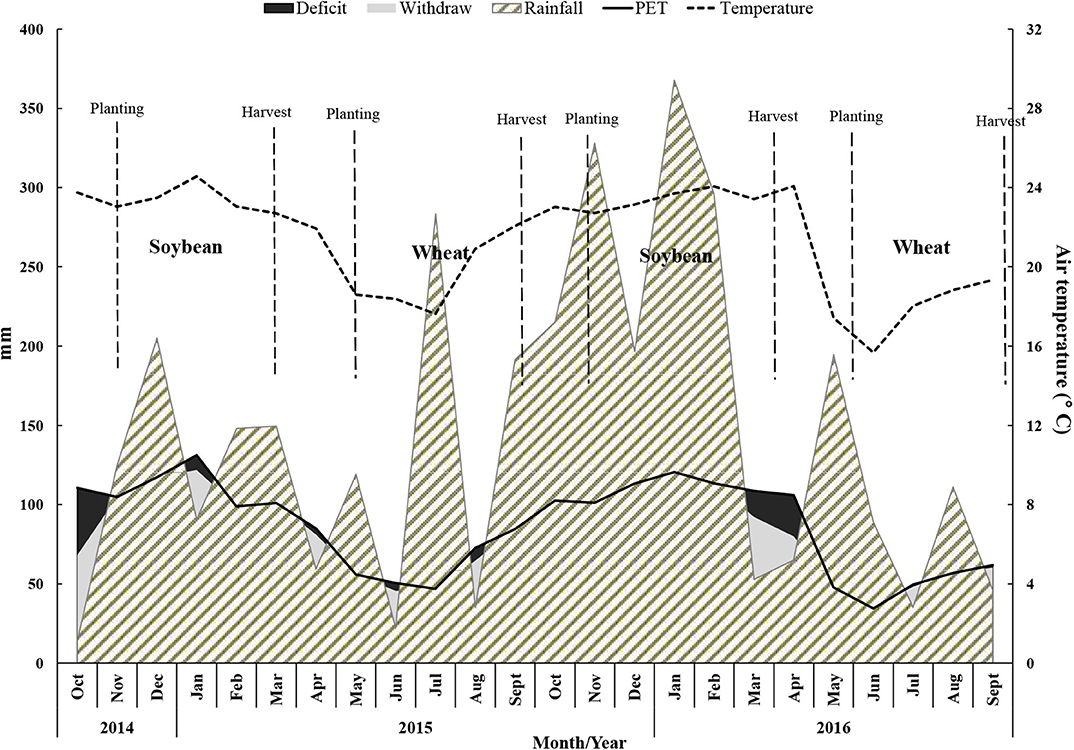
Figure 2. Sequential water balance in the soybean and wheat crop seasons (2014–2016) according to Thornthwaite and Mather (1955). PET, potential evapotranspiration withdraw, H2O removal system, and air temperature. Londrina, Paraná State, Brazil.
The experiment was set up as a randomized block design in a 2 × 4 factorial scheme [two application methods (broadcast, total area of plot, and band application together with the seed) and four P2O5 rates (0, 30, 60, and 120 kg ha−1, equivalent to 0, 13.1, 26.2, and 52.4 kg ha−1 of P)] in a split-plot arrangement (growing season), with four replicates. For the first cultivation, the soybean cv. ‘M5947 IPRO' crop was grown in plots of 4.0 × 8.0 m with a row spacing of 0.5 m. After each soybean crop, wheat cv. ‘Pardela' was cultivated in succession with a spacing of 0.175 m to quantify the residual effects of phosphate application to the soybean crop. Phytosanitary treatments and weed control of the soybean and wheat crops were carried out according to the recommendations described in TPS (2013) and ITTT (2011).
The micronutrients (B, Cu, Fe, Mn, and Zn) were applied in the form of salts mixed with 2.0 Mg ha−1 of gypsum (CaSO4·2H2O). In the second cultivation, fertilization of the soybean crop was based on soil chemical analysis sampled after the first wheat crop and carried out according to Moreira et al. (2019b). In both soybean cultivations, seeds were inoculated with Bradyrhizobium elkanii SEMIA 587 and SEMIA 5019 (4.0 × 109 viable cells g−1) and treated with a solution containing 20 g ha−1 of molybdenum (Mo), 2.0 g ha−1 of cobalt (Co), and 10 g ha−1 of nickel (Ni). For the second soybean crop, in addition to the P2O5 treatments, the experimental area received 183 kg ha−1 of potassium chloride [KCl (60% K2O)] (Moreira et al., 2019b). In both cultivations, the wheat crop received 180 kg ha−1 of urea (45% N) in sowing.
At the R2 reproductive stage, leaves 3 and 4 were collected at random from the apex of 30 plants to determine the nutritional status and chlorophyll level of the plants with hand-held chlorophyll meters (SPAD-502, Minolta, Japan) of the plants, afterwards, the data were transformed in chlorophyll contents (mg cm−2) using the equation y = 16.033 + (7.5774 × SPAD) using the equation y = 16.033 + (7.5774 × SPAD) (Moreira et al., 2020). The leaves were collected and dried under forced ventilation oven at 65 ± 5 °C until constant weight. The total N was extracted by sulfuric digestion and determined by the micro-Kjeldahl method (Nelson and Sommers, 1972). The total P, K, Ca, Mg, S, B, Cu, Fe, Mn, and Zn concentrations were extracted by digestion in a nitric-perchloric solution. The total P concentration was determined by spectrophotometry with molybdenum blue and the S concentration by turbidimetry. The total K, Ca, Mg, Cu, Fe, Mn, and Zn concentrations were analyzed by atomic absorption spectrophotometry, according to the methods described by Malavolta et al. (1997). Soil chemical analyses (pH, C, P, K, Ca, Mg, S, B, Cu, Fe, Mn, and Zn) were carried out according to the methodologies described in Teixeira et al. (2017).
At the R6 growth stage (Fehr et al., 1971), 30 soybean plants were collected from the four central rows in each plot to determine the number of pods (NP), number of grains per pod (NGP), and plant height (PH). Soybean grain yield (GY) and 100 grain mass (R8 stage) were determined from an area of 3.0 × 7.0 m, leaving a 0.5-m border on all sides of each plot.
For the wheat crop, at the 10.1 stage, leaves were collected from 30 plants at random within each treatment to determine the nutritional status (N, P, K, Ca, Mg, S, Cu, Fe, Mn, and Zn—as per Malavolta et al., 1997), and chlorophyll level (SPAD-502, Minolta, Japan), and transformed with the equation described by Uddling et al. (2007). The GY, PH, hectoliter volume (HV), number of spikelet (NS), number of spikelets per clump (NSC), and 1000 grain mass were quantified. At the end of the crop cycle (harvest), soils were sampled from each treatment at a depth of 0–0.1 m to quantify available P with Mehlich 1 and resin extractants as described by Teixeira et al. (2017).
Normality of the distribution of the traits was tested via Shapiro–Wilk's normality test (Shapiro and Wilk, 1965), testing the null hypothesis that the sample belongs to a population with normal distribution with the statistic X (0 < X < 1); if X is equal to 1, the data perfectly fit normal distribution, whereas small values of X are evidence of deviations from normality. The value of the statistic and the associated p-value were obtained; if this p-value was less than the nominal value of significance p ≤ 0.05, the null hypothesis of normality was rejected. Normality of residuals was examined using the UNIVARIATE procedure (p ≤ 0.05). Squared and absolute values of residuals were examined with Levene's Test to confirm homogeneity of variances (p ≤ 0.05). After the normality test, the treatment variance data (soybean and wheat) were subjected to analysis of variance (ANOVA) and F-test using the standard least squares procedure of JMP by SAS. Regression and Pearson product-moment correlations were derived using the REG procedure of SAS to investigate the relation between P2O5 rates with grain yield (GY), yield components, nutrient concentrations, and chlorophyll level of soybean and wheat, and the regression equations for GY were chosen according to the best fit of the points within the curve. Where there was interaction of treatments × growing seasons (p ≤ 0.05), the data were separated for each growing season.
There was an interaction of P2O5 rate and application method on GY for both the soybean (Figure 3) and wheat (Figure 4) crops. In the two growing seasons, the yield of soybeans responded to the P2O5 application with a quadratic effect in the first and a linear effect in the second cultivation cycle. In addition, the results from the GY regression analysis under the effect of P2O5 rates indicated that, when grown in a Typic Eutrorthox, the broadcast application for the soybean crop showed an average value for the two harvests that was 5.4% higher for the maximum estimated rate (MER) of 99.8 kg ha−1 of P2O5 for the band application at sowing method and 129.3 kg ha−1 for the broadcast method with a MER of 115.0 kg ha−1 for the mean of the two application methods (Figure 2). These values are beyond the official recommendation for yield 3.0 to 4.0 Mg ha−1 (Moreira et al., 2019b). The wheat crop GY also increased with increasing P2O5 rates, but there was no effect of the application method (Figure 4). However, there was less yield in the second crop, probably due to less rain at the beginning of flowering (Figure 2). The mean GY of the two crops varied from 2,975.5 kg ha−1 for the MER of 91.8 kg ha−1 of P2O5 applied using the band application method to 2,977.7 kg ha−1 for the MER of 99.7 kg ha−1 of P2O5 applied using the broadcast approach.
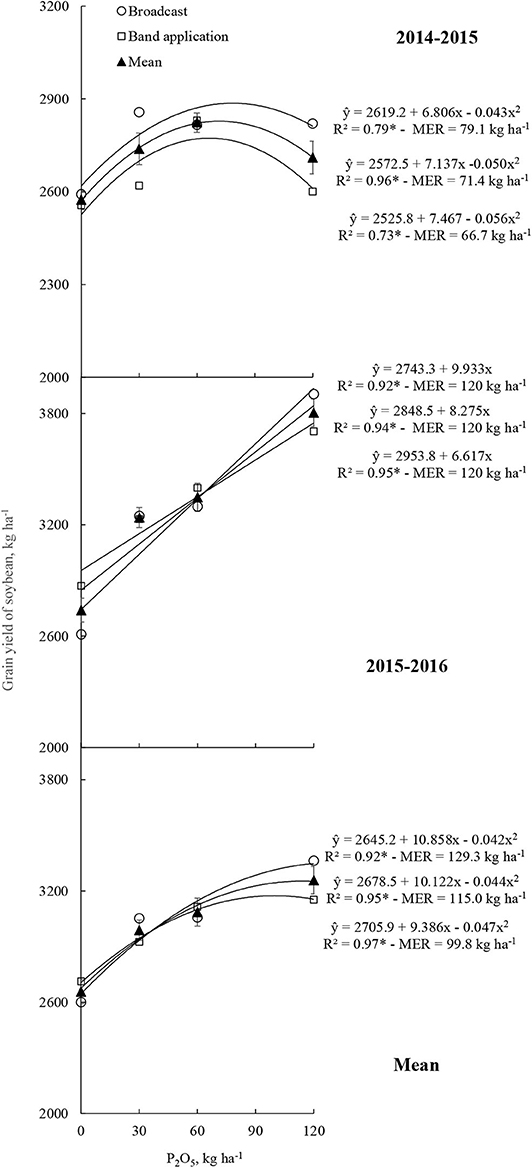
Figure 3. Relationship of the effect of P2O5 rates applied through broadcast or band application in soybean crop, and soybean grain yield in two growing season. MER, maximum estimated rate. *Significant (F-test, p ≤ 0.05). Londrina, Paraná State, Brazil.
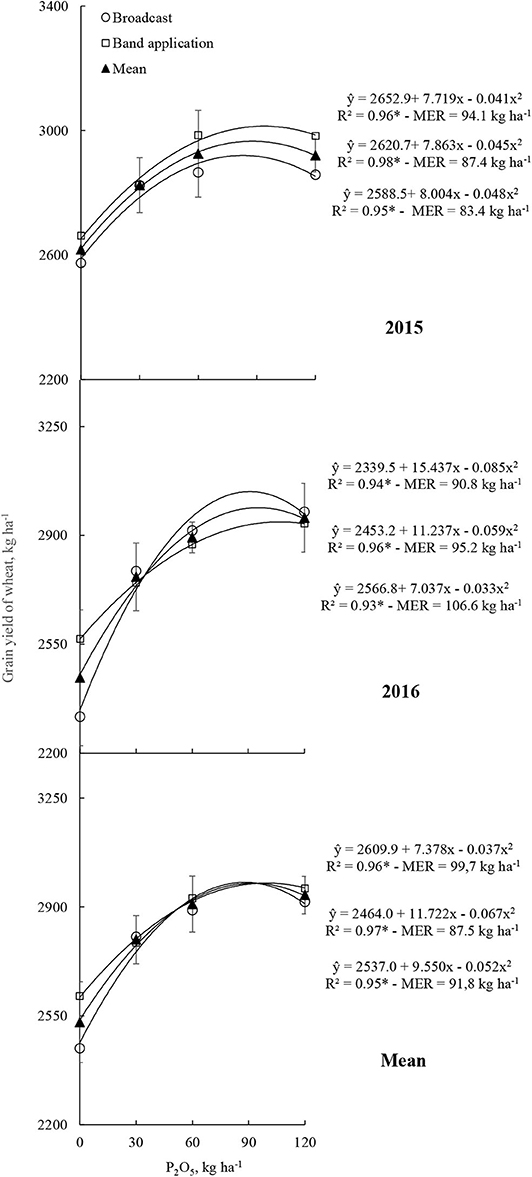
Figure 4. Relationship of the residual effect of P2O5 rates applied through broadcast or band application in soybean crop and wheat grain yield in two growing seasons. MER, maximum estimated rate. *Significant (F-test, p ≤ 0.05). Londrina, Paraná State, Brazil.
Similar results reflecting the positive effects of P2O5 rates on GY of soybeans and wheat have been reported by Moreira et al. (2014) and Blue et al. (1990). Regarding the P2O5 rates and the two application methods, Heckman and Kamprath (1992) and Borges and Mallarino (2000) obtained positive responses in soybean GY with an increase in P rates application in the soil with both application methods. The band application or broadcast method showed no difference, even with available P levels in the soil within ranges considered low and very low (Moreira et al., 2019b). A low soil P level was a characteristic of the present study, where the average P content available in the soil before planting was 3.7 mg kg−1 (determined using the Mehlich 1 extractant). In a cultivation study carried out under “Cerrado” conditions, in a Typical Oxisol with a clayey texture and low P concentration, Broch and Chueiri (2005) obtained similar soybean yields when applying P fertilizer using the broadcast or the band application method. Regarding yield components, only the chlorophyll levels and number of grains per plant (NGP) in soybean crop and the number of spikelets (NS), and chlorophyll levels in wheat were significantly influenced by the P2O5 rates (Table 1). Fageria et al. (2011, 2013) reported that in phosphate fertilization studies, the NGP and NS have a greater influence in increasing GY as compared with other yield components, while P in the plants acts directly as an energy donor in the process of photosynthesis (Malavolta et al., 1997).
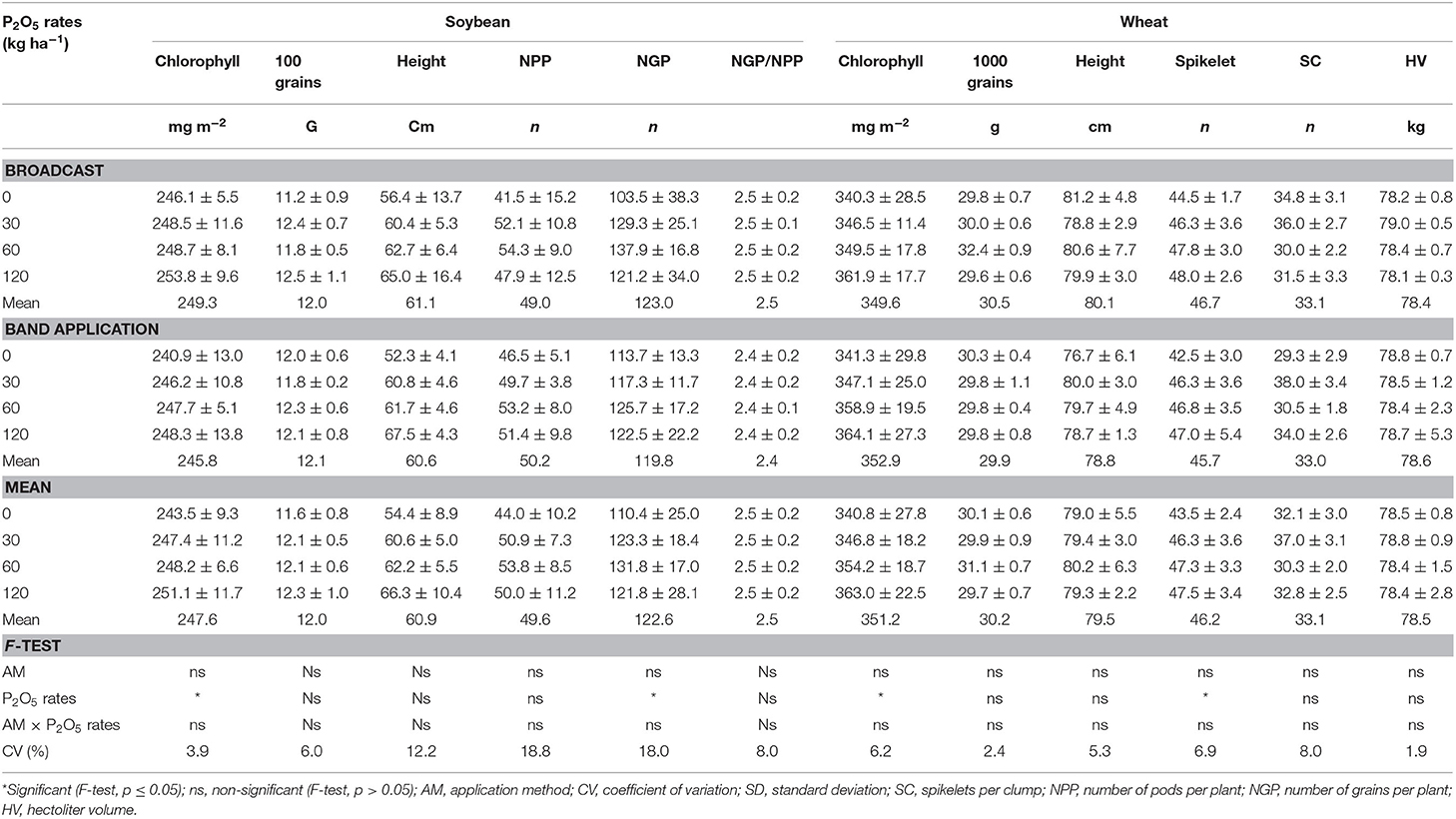
Table 1. Yield components and chlorophyll level as influenced by P2O5 rates, under broadcast and band application, on the average of two growing seasons of a soybean–wheat cropping system, Londrina, Paraná State, Brazil.
Studies by Anghinoni (1992) and Sousa et al. (2002) have shown that rates higher than 100 kg ha−1 of P2O5 can be applied using the broadcast method without influencing the GY. Resende et al. (2006) and Borges and Mallarino (2003) investigated P sources, P rates, and application methods in corn (Zea mays L.) and soybean crop and observed that fertilization by broadcast and/or band application with soluble P sources yielded similar productivity. Prado et al. (2001) point out that in soils with a low P concentration, the adsorption of this nutrient is maximized when the phosphate fertilizer is applied as a broadcast with incorporation. This application methods lead to a greater contact of the P with the solid phase of the soil and, at the same time, the P contact with the plant root system is reduced. According to Lana et al. (2003), where there is non-incorporation of fertilizer in the soil, P fertilization can reduce losses due to fixation, being provisionally adsorbed on SOM, which becomes available to plants after mineralization (Anderson, 1980) and provides greater root development in the topsoil (Barber, 1995). Another factor to be highlighted is that in NTM, characterized by greater SOM accumulation in the upper layers of the soil, the restrictive effect described by Novais and Smyth (1999) was not observed. This restrictive effect is that more weathered tropical soils with high fixation power represent a drain preferential of P, and the broadcast application of P2O5 proves inadequate to meet plant demands. Although the results of the present study indicate better plant responses with broadcast application of P2O5, it is worth mentioning that due to the slope of the land and excessive rain (runoff effect), the band application at sowing method can reduce fertilizer losses by laminar leaching (Borges and Mallarino, 2003).
In this study, the available P levels in the soil under soybean and wheat crops showed linear increases in Mehlich 1 (P-M1) and ion exchange resin (P-RE) in relation to P2O5 rates (Table 2). In Brazil, these two methods are considered official; however, the interpretations must be in accordance with the corresponding calibrations made in each region of the country. The P-M1 extractant available P-values were lower than the P-RE values extracted until 5.7 times as much available P as that of P-M1, a result similar to that observed by Moreira and Malavolta (2001). In addition, both had a high correlation coefficient (soybean: y (P-RE) = 6.628 + 3.202 (P-M1), r = 0.90, and wheat: y (P-RE) = 1.127 + 4.264 (P-M1), r = 0.86, p ≤ 0.05). These results confirm the findings of Moreira et al. (1997) and Moreira and Malavolta (2001) for these two extractants, indicating that both are efficient ways of quantifying P availability in the soil. The P available with the Resin method increased from the first to second crop in wheat (Table 2), possibly due to the positive effect of the applied gypsum recovering the P in depth, and the greater sensitivity of extractant in quantifying the availability of nutrient in the soil.
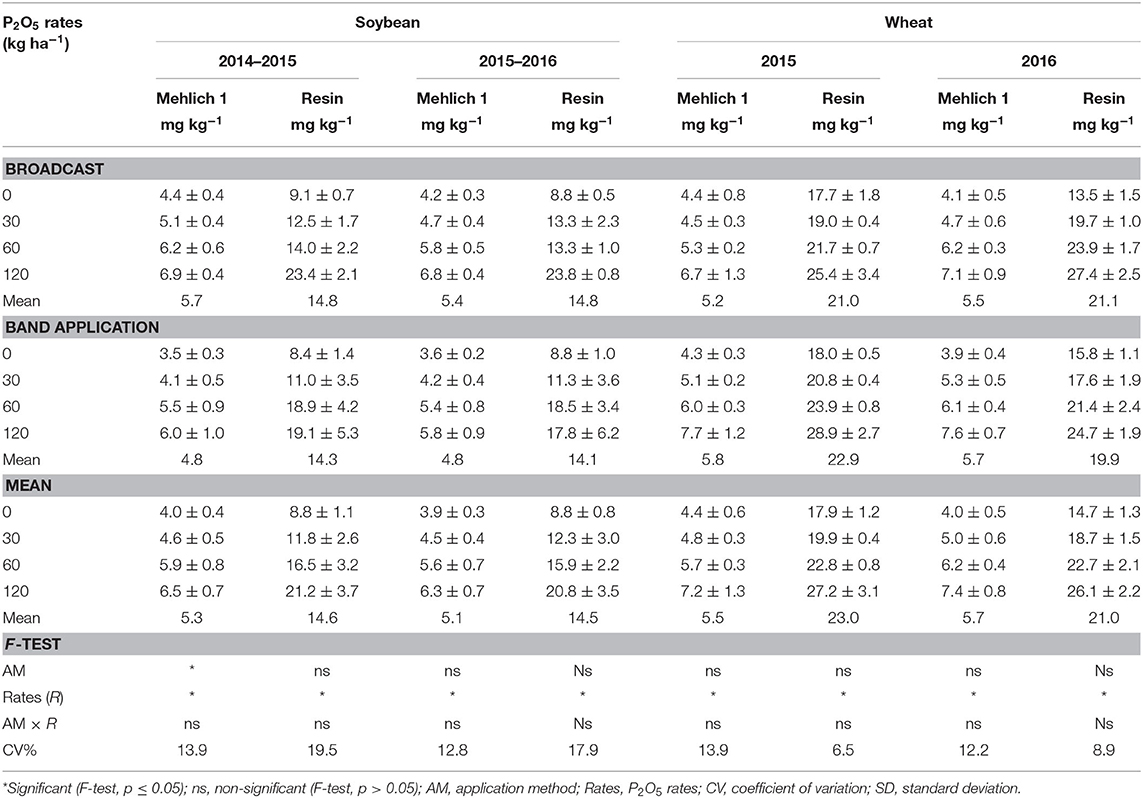
Table 2. Phosphorus availability in the soil with Mehlich 1 and resin extractants after a soybean-wheat cropping system due to the P2O5 rates and application method (AM) (broadcast and band application), Londrina, Paraná State, Brazil.
There was a significant relationship between application methods and soybean leaf P, Ca, and S concentrations. Band application at a rate of 120 kg ha−1 of P2O5 resulted in a higher foliar P concentration than for the other rate treatments. However, it did not differ significantly from the broadcast application at the same rate (Table 3). The both methods types, the P-M1 and P-RE were well correlated with foliar P concentration for both species (r = 0.65* and r = 0.56*, for soybean; r = 0.58* and r = 0.56*, for wheat, respectively, p ≤ 0.05), that is, the relationship between P-M1 and foliar P concentration was better than that of P-RE and foliar P concentration. Similar results were obtained by Antonangelo et al. (2019) with P rates in the same edaphoclimatic conditions. For K, there was no statistical difference; however, it was observed that P2O5 application using the band application method at a rate of 120 kg ha−1 resulted in a 7.0% higher K concentration in soybean leaves in comparison with application using the broadcast method. Probably, there must have been an increase in root volume in depth with the P application in the band application with a consequent increase in the K concentration in the plant. The foliar Ca concentration showed a linear effect (y = 8.120 + 0.004x, R2 = 0.68, p ≤ 0.05) only in the application to the broadcast, possibly due to the P source used that contained 12–14% Ca (Ribeiro et al., 1999). For leaf Mg, B, Cu, Fe, Mn, and Zn concentrations, there were no significant differences between treatments (Table 3). Rosa et al. (2015), in studies on P2O5 rates and application methods in soybean crop, observed that the broadcast approach was more effective at increasing the P, K, Ca, S, Mn, and Zn concentrations in the leaves than the band application method. Despite this variability, the foliar nutrient levels found in this study are within the ranges considered by Urano et al. (2006) as adequate in soybean crop. In this study, the negative P × Zn interaction was not observed in the uptake of these nutrients by plants as described by Malavolta et al. (1997) and verified by Moreira et al. (2006) in alfalfa (Medicago sativa L.) crop. Regarding the foliar nutrient concentrations of the wheat crop (Table 4), the only significant effect was of residual P2O5 rates on the P concentration (y = 2.080 + 0.006x, R2 = 0.77, p ≤ 0.05). The leaf N, K, Ca, Mg, S, B, Cu, Fe, Mn, and Zn concentrations in wheat were not influenced by growing season and treatments, and were close to the concentrations according with Malavolta et al. (1997) and obtained by Moreira et al. (2019a) in a study on the soybean-wheat intercropping system with Cu rates cultivated under the same soil and climate conditions.
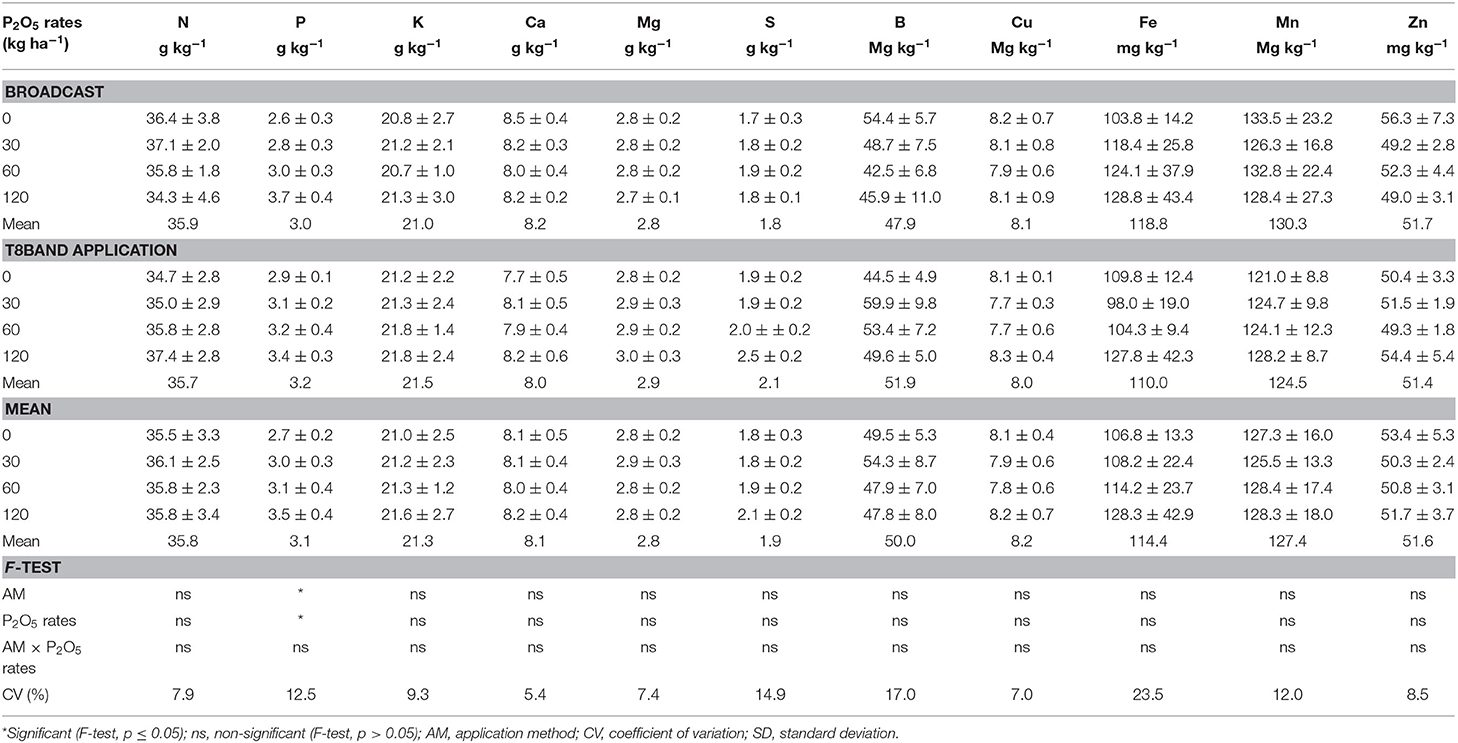
Table 3. Leaf N, P, K, Ca, Mg, S, B, Cu, Fe, Mn, and Zn concentrations as influenced by P2O5 rates, with two application methods (AM) (broadcast or band application), on the average of two growing seasons of soybean crops, Londrina, Paraná State, Brazil.

Table 4. Leaf N, P, K, Ca, Mg, S, B, Cu, Fe, Mn, and Zn concentrations as influenced by the P2O5 rates, with two application methods (AM) (broadcast or band application), on the average of two growing seasons of wheat crops, Londrina, Paraná State, Brazil.
Fertilization with a soluble phosphate source (triple superphosphate) in a soybean-wheat cropping system under NTM and subtropical conditions increased the productivity of soybeans and wheat over two growing seasons, regardless of the application method used (broadcast or band application). Given the similarity in soybean and wheat yield responses observed in this study, it is advised that the cost-benefit ratio for selecting the best method of P2O5 application should largely be determined by the difference in application costs and the relief of the area to be cultivated. The MER obtained for the mean of the two application methods are beyond the official recommendation for yield 3.0–4.0 Mg ha−1. The soybean and wheat foliar P concentrations and the soil available P at a 0–0.1 m depth (determined using P-M1 and P-RE) were, for the most part, influenced by the P2O5 rates and not by the P application methods. Available P in the soil extracted by P-M1 and P-RE was highly correlated, with P-RE extracting until 5.7 times as much available P as P-M1.
The datasets presented in this article are not readily available because no requests to access the datasets should be directed to Adônis Moreira, YWRvbmlzLm1vcmVpcmFAZW1icmFwYS5icg==.
AM: conducting the experiment, data tabulation, statistical analysis, and text writing. LM: conducting the experiment, and text writing. RP: conducting the experiment, and data tabulation. All authors contributed to the article and approved the submitted version.
The authors declare that the research was conducted in the absence of any commercial or financial relationships that could be construed as a potential conflict of interest.
To the staff of Soil Fertility and Microbiology of Embrapa Soja for conducting the field experiments, the Santa Rita Laboratory for soil and plant analysis, and to the National Council of Technological and Scientific Development (CNPq) for providing scholarships to the first author.
Anderson, G. (1980). “Assessing organic phosphorus in soils,” in The role of phosphorus in agriculture, eds F. E. Khasawneh, E. C. Sample, and E. J. Kamprath (Madison, WI: American Society of Agronomy), 411–431. doi: 10.2134/1980.roleofphosphorus.c16
Anghinoni, I. (1992). Use of phosphorus by corn as affected by the fraction of soil fertilized with soluble phosphate. Rev. Bras. Ci. Solo 16, 349–353.
Antonangelo, J. A., Firmano, R. F., Alleoni, L. R. F., Oliveira Junior, A., and Zhang, H. (2019). Soybean yield response to phosphorus fertilization in an oxisol under long-term no-till management. Soil Sci. Soc. Am. J. 83, 173–180. doi: 10.2136/sssaj2018.07.0251
Barber, S. A. (1995). Soil nutrient bioavailability: a mechanistic approach. London: Wiley and Sons.
Blue, E. N., Mason, S. C., and Sander, D. H. (1990). Influence of planting date, seeding rate, and phosphorus rate on wheat yield. Agron. J. 82, 762–768. doi: 10.2134/agronj1990.00021962008200040022x
Borges, R., and Mallarino, A. P. (2000). Grain yield, early growth, and nutrient uptake of no-till soybean as affected by phosphorus and potassium placement. Agron. J. 92, 380–388 doi: 10.2134/agronj2000.922380x
Borges, R., and Mallarino, A. P. (2003). Broadcast and deep-band placement of phosphorus and potassium for soybean managed with ridge tillage, Soil Sci. Soc. Am. J. 67, 1920–1927. doi: 10.2136/sssaj2003.1920
Broch, D. L., and Chueiri, W. A. (2005). Estratégias de adubação na cultura da soja cultivada sob sistema de plantio direto. Maracaju: Fundação MS/Manah.
Fageria, N. K., Knupp, A. M., and Moraes, M. F. (2013). Phosphorus nutrition of lowland rice in tropical lowland soil. Comm. Soil Sci. Plant Anal. 44, 2932–2940. doi: 10.1080/00103624.2013.829485
Fageria, N. K., Moreira, A., and Castro, C. (2011). Response of soybean to phosphorus fertilization in Brazilian Oxisol. Comm. Soil Sci. Plant Anal. 42, 2716–2723. doi: 10.1080/00103624.2011.622819
Fehr, W. R., Caviness, C. E., Burmood, D. J., and Pennington, J. S. (1971). Stage of development description for soybean (Glycine max [L.] Merrill). Crop Sci. 11, 929–931. doi: 10.2135/cropsci1971.0011183X001100060051x
Fidelis, R. R., Rocha, R. N. C., Leite, U. T., and Tancredi, F. D. (2003). Some aspects of no-tillage system on soybean. Biosci. J. 19, 23–31.
Fixen, P. E., and Halvorson, A. D. (1991). Optimum phosphorus management for small grain production. Better Cr. Plant Food 75, 26–29.
Hansel, F. D. (2019). Soluble phosphate fertilizers and placement strategies in soybean. Pesq. Aplic. Agrotec. 12, 23–32.
Heckman, J. R., and Kamprath, E. J. (1992). Potassium accumulation and corn yield related to potassium fertilizer rate and placement. Soil Sci. Soc. Am. J. 56, 141–148. doi: 10.2136/sssaj1992.03615995005600010022x
ITTT (2011). Technical information for wheat and triticale [Informações técnicas para trigo e triticale]. Dourados: Embrapa Agropecuária Oeste.
Lacerda, J. J. J., Resende, A. V., Furtini Neto, A. E., Hickmann, C., and Conceição, O. P. (2015). Fertilization, grain yield and profitability of the rotation between soybean and corn in soil with improved fertility. Pesq. Agropec. Bras. 50, 769–778. doi: 10.1590/S0100-204X2015000900005
Lana, R. M. Q., Vilela Filho, C. E., Zanão Júnior, L. A., Pereira, H. S., and Lana, A. M. Q. (2003). Superficial fertilization with phosphorus and potassium in the soy crop (Glycine max (L.) Merrill) at different sowing times in pre sowing under a no-tillage system implantation. Sci. Agraria 4, 53–60. doi: 10.5380/rsa.v4i1.1066
Malavolta, E., Vitti, G. C., and Oliveira, S. A. (1997). Evaluation of nutritional staus of plants; principles and applications [Avaliação do estado nutricional das plantas: princípios e aplicações]. Piracicaba: Potafos.
Moreira, A., Heinrichs, R., Carvalho, J. G., and Ferreira, R. P. (2006). Effect of phosphorus and magnesium relationship on concentration and content of micronutrients in alfalfa. B. Indústr. Anim. 63, 55–61.
Moreira, A., and Malavolta, E. (2001). Sources, rates and extractants of phosphorus on alfalfa and centrosema. Pesq. Agropec. Bras. 36, 1519–1527. doi: 10.1590/S0100-204X2001001200009
Moreira, A., Malavolta, E., Virgens Filho, A. C., Silveira, R. L. V. A., and Abreu, J. B. R. (1997). Evaluation of phosphorus availability in soils by isotopic, chemical and biological methods. Sci Agric. 54, 78–84. doi: 10.1590/S0103-90161997000100011
Moreira, A., Moraes, L. A. C., Provenzano, R. S., and Cabrera, R. A. D. (2020). Effect of sulfur source and rates on yield and yield components of soybean in subtropical soils. J. Plant Nutr. 43, 2081–2091. doi: 10.1080/01904167.2020.1771584
Moreira, A., Moraes, L. A. C., and Schroth, G. (2019a). Copper fertilization in soybean-wheat intercropping under no-till management. Soil Till. Res. 193, 133–141. doi: 10.1016/j.still.2019.06.001
Moreira, A., Motta, A. C. V., Costa, A., Muniz, A. S., Cassol, L. C., Zanão Júnior, L. A., et al. (2019b). Fertilization and liming manual for the Paraná State [Manual de adubação e calagem para o Estado do Paraná]. Curitiba: SBCS, Núcleo Estadual do Paraná.
Moreira, A., Sfredo, G. J., Moraes, L. A. C., and Fageria, N. K. (2014). Agronomic efficiency of two types of lime and phosphate fertilizer sources in Brazilian cerrado soils cultivated with soybean. Comm. Soil Sci. Plant Anal. 45, 2319–2330. doi: 10.1080/00103624.2014.932372
Nelson, D. W., and Sommers, L. E. (1972). A simple digestion procedure for estimation of total nitrogen in soils and sediments. J. Environ. Qual. 1, 423–425. doi: 10.2134/jeq1972.00472425000100040020x
Novais, R. F., and Smyth, T. J. (1999). Phosphorus in soil and plant in tropical conditions. [Fósforo em solo e planta em condições tropicais]. Viçosa: Universidade Federal de Viçosa.
Prado, R. M., Fernandes, F. M., and Roque, C. G. (2001). Effects of fertilizer placement and levels of phosphorus on foliar phosphorus content and corn yield. Rev. Bras. Ci. Solo 25, 83–90. doi: 10.1590/S0100-06832001000100009
Resende, A. V., Furtini Neto, A. E., Alves, V. M. C., Muniz, J. A., Curi, N., Faquin, V., et al. (2006). Phosphorus sources and application methods for maize in soil of the Cerrado region. Rev. Bras. Ci. Solo 30, 453–466. doi: 10.1590/S0100-06832006000300007
Ribeiro, A. C., Guimarães, P. T. G., and Alvarez-Venegas, V. H. (1999). Recommendation for use of correctives and fertilizers in Minas Gerais (5th approximation) [Recomendação para uso de corretivos e fertilizantes em Minas Gerais (5aaproximação)]. Viçosa: Universidade Federal de Viçosa.
Rosa, R. P., Pittelkow, F. K., and Pasqualli, R. M. (2015). Doses e métodos de aplicação de fósforo na cultura da soja. Lucas do Rio Verde: Fundação Rio Verde.
Rossi, C. Q., Pereira, M. G., Giácomo, S. G., Marconi, B., and Polidoro, J. C. (2013). Litter decomposition and nutrient release from brachiaria, sorghum and soybean in no-tillage areas in the Cerrado region, Goiás. Semina Ciência Agrárias 34, 1523–1534. doi: 10.5433/1679-0359.2013v34n4p1523
Sfredo, G. J. (2008). Liming and fertilizing of soybeans [Calagem e adubação da soja]. Londrina: Embrapa Soja.
Shapiro, S. S., and Wilk, M. B. (1965). An analysis of variance test for normality (complete samples). Biometrika 52, 591–611. doi: 10.1093/biomet/52.3-4.591
Sousa, D. M. G., Lobato, E., and Rein, T. A. (2002). “Adubação com fósforo,” in Cerrado: correção do solo e adubação, eds D. M. G. Sousa and E. Lobato (Planaltina: Embrapa Cerrados), 147–168.
Stainer, J. L., Schomberg, H. H., Unger, P. W., and Cresap, J. (2000). Biomass and residue cover relationships of fresh and decomposing small grain residue. Soil Sci. Soc. Am. J. 64, 2109–2114. doi: 10.2136/sssaj2000.6462109x
Teixeira, P. C., Donagemma, G. K., Fontana, A., and Teixeira, W. G. (2017). Manual of soil analysis methods [Manual de métodos de análise de solo]. Rio de Janeiro: Embrapa Solos.
Thornthwaite, C. W., and Mather, J. R. (1955). The water balance. Centerton, NJ: Drexel Institute of Technology - Laboratory of Climatology.
TPS (2013). Tecnologias de produção de soja - região central do Brasil 2012 e 2013. Londrina: Embrapa Soja.
Uddling, J., Gelang-Alfredsson, J., Piikki, K., and Pleijel, H. (2007). Evaluating the relationship between leaf chlorophyll concentration and SPAD-502 chlorophyll meter readings. Photosynth. Res. 91, 37–46. doi: 10.1007/s11120-006-9077-5
Keywords: Glycine max, Triticum aestivum, broadcast application, band application, nutritional state of plants, subtropical conditions, Typical Eutrorthox
Citation: Moreira A, Moraes LAC and Petineli R (2020) Phosphate Fertilizer in Soybean-Wheat Cropping System Under No-Till Management. Front. Sustain. Food Syst. 4:564586. doi: 10.3389/fsufs.2020.564586
Received: 22 May 2020; Accepted: 12 August 2020;
Published: 15 October 2020.
Edited by:
Paulo Mazzafera, Campinas State University, BrazilReviewed by:
Renan Caldas Umburanas, University of São Paulo, BrazilCopyright © 2020 Moreira, Moraes and Petineli. This is an open-access article distributed under the terms of the Creative Commons Attribution License (CC BY). The use, distribution or reproduction in other forums is permitted, provided the original author(s) and the copyright owner(s) are credited and that the original publication in this journal is cited, in accordance with accepted academic practice. No use, distribution or reproduction is permitted which does not comply with these terms.
*Correspondence: Adônis Moreira, YWRvbmlzLm1vcmVpcmFAZW1icmFwYS5icg==
Disclaimer: All claims expressed in this article are solely those of the authors and do not necessarily represent those of their affiliated organizations, or those of the publisher, the editors and the reviewers. Any product that may be evaluated in this article or claim that may be made by its manufacturer is not guaranteed or endorsed by the publisher.
Research integrity at Frontiers

Learn more about the work of our research integrity team to safeguard the quality of each article we publish.